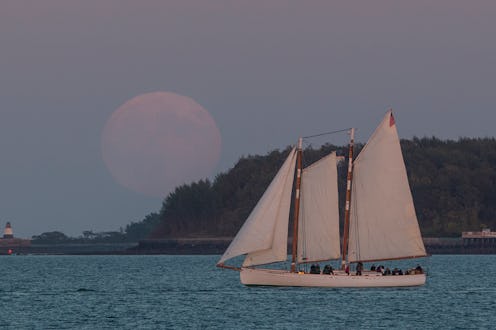Life
Next Week’s Full Moon Is Going To Be The First Of Its Kind In Over 150 Years

January has been off to an astronomical start — literally. First, we rung in the new year with a super moon, and now, we're looking forward to an even more awesome sky show that's so rare, it hasn't occurred in the Americas for over 150 years: A super blue blood moon. You might be wondering what a super blue blood moon is, and that's likely because it's a mouthful, and also because you've been hearing buzz about it for weeks already. And while I'll admit that often celestial events are blown totally out of proportion, the full moon on Jan. 31 is truly a special one, worth all of the hubbub.
A super blue blood moon is actually four different things: It's common for the moon to take on any one of these appearances, but all four together is something that hasn't happened in over a century for us in the United States. Aside from being a tongue-twister, the super blue blood moon describes the four different conditions the moon will be in and how that will effect how we see it. Full, eclipsed, close to Earth, and twice present in one month.
While all of us in America will have some kind of special stargazing experience on Jan. 31, the west coast is going to have a much better view, being able to see the complete totality of a lunar eclipse, which will create the "blood" aspect of the moon's appearance. Us on the East Coast will only catch a sliver of the eclipse, meaning that only a sliver of the moon will appear "blood" colored — an interesting sight, nonetheless. As the moon sits in the earth's shadow, as the two celestial giants are perfectly aligned at 5:51 a.m. EST on the early morning of Jan. 31, the moon will take on a rusty orange glow, as a result of the earth blocking some of the sun's light that we typically see reflecting onto the surface of the moon. Astronomers believe that the reason why the moon appears reddish, rather than simply dull, is because the red rays of light that are scattered through the earth's atmosphere are best at reaching the moon during an eclipse.
The super aspect of the moon, of course refers to it being a super moon, the second super moon of the month! A super moon is a special kind of full moon that occurs during the moon's closest proximity to Earth. During a super moon, the moon looks brighter and closer than usual, creating a visual effect of it being larger — though of course, the moon is always the same size. Because of the moon's closeness to earth, it will likely shine brighter, which will be very useful if it's a cloudy night.
And perhaps the most rare aspect of January's second full moon, is the blue aspect. While the moon will not at any point appear blue, it will be rare: it is the third full moon in an astronomical season that hosts four full moons, and it's the second full moon in a month with two full moons. Lucky for us, we'll actually have another blue moon this year in March.
All of these exciting conditions together will create a very memorable view. Though you'll have to get up extra early to see it — while most exciting star shows have a peak visibility in the dark of the night, the Jan. 31 celestial programming will become most interesting just before sunrise. So set your alarm and drag yourself out of bed. The sight will definitely be worth braving the early morning cold for. It might be the best thing you get out of bed early for all year.